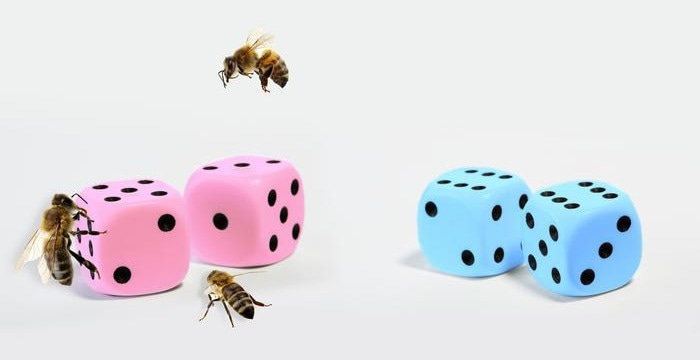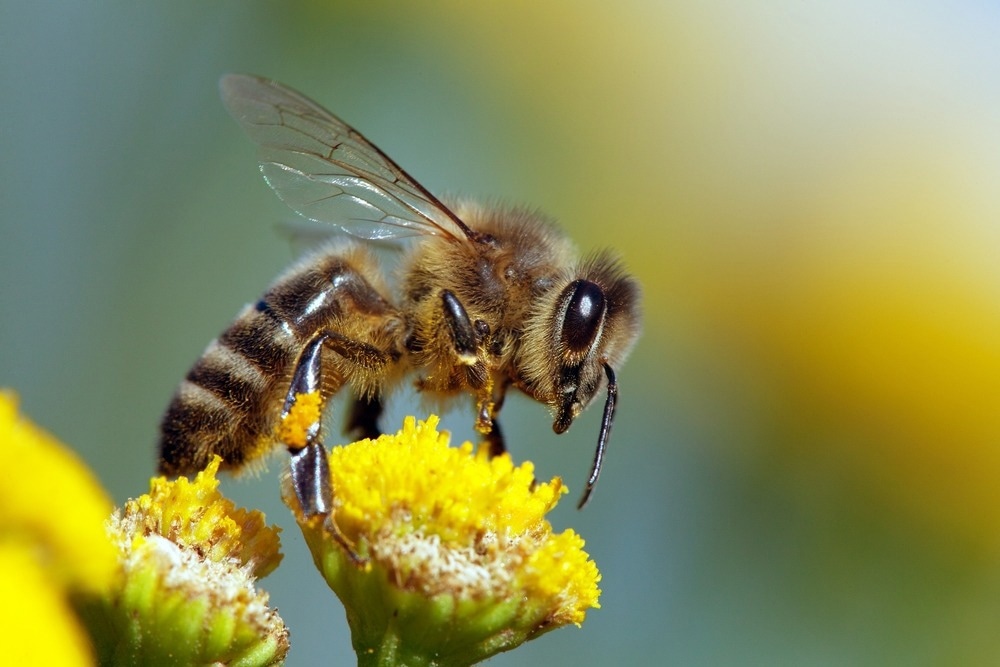Reviewed by Danielle Ellis, B.Sc.Oct 5 2023
Until now, it has been unknown how a bee’s sex is decided. A team of biologists and chemists from Heinrich Heine University Düsseldorf (HHU) has found a critical gene and the chemical process that goes with it. They describe how this process is analogous to a dice game in the current edition of the scholarly journal Science Advances.
 The Csd gene, of which there may be more than 100 variants, plays a key role in determining the sex of bees. These genes are brought together during sexual reproduction: Where the genome subsequently contains two different variants of the Csd gene, a female bee develops, which is then raised (left). Where fertilisation brings together two variants that are the same, a male bee would develop, but it is not raised by the worker bees. Male bees—the drones—are instead generated via asexual reproduction. (Fig.: HHU/Paul Schwaderer/stock.adobe.com—Alekss, Tran-Photography). Image Credit: HHU/Paul Schwaderer/stock.adobe.com – Alekss, Tran-Photography
The Csd gene, of which there may be more than 100 variants, plays a key role in determining the sex of bees. These genes are brought together during sexual reproduction: Where the genome subsequently contains two different variants of the Csd gene, a female bee develops, which is then raised (left). Where fertilisation brings together two variants that are the same, a male bee would develop, but it is not raised by the worker bees. Male bees—the drones—are instead generated via asexual reproduction. (Fig.: HHU/Paul Schwaderer/stock.adobe.com—Alekss, Tran-Photography). Image Credit: HHU/Paul Schwaderer/stock.adobe.com – Alekss, Tran-Photography
The sex of a living species has profound implications for its form, function, and behavior. An organism’s biological sex is generally decided at the beginning of its life. In humans, for example, the existence of the sex-determining “Y chromosome” determines whether a male is born.
In 1845, the Silesian priest Johann Dzierzon began researching the sex-selection processes of honeybees (Apis mellifera). Among other things, he found that male bees can reproduce asexually, producing “drones”.
In contrast to humans, bees do not only have one chromosome that determines their sex. A study team led by Professor Dr Martin Beye from the Institute of Evolutionary Genetics at Harvard University has recently proven that a single gene known as “Csd” (Complementary sex determiner) uses a unique method to determine sex.

Image Credit: Daniel Prudek/Shutterstocl.com
More than 100 different alleles, or variants, can exist for this gene. In other situations, such as in flowers, the different alleles of a gene might affect the color of the petal.
The simple chromosome sets from the egg and sperm cells combine during sexual fertilization to form a double-diploid chromosomal set. As a result, each sexually fertilized bee now possesses two Csd gene variations.
The second discovery made by the Düsseldorf bee researchers is that female bees grow in regions where the two Csd alleles are different. On the other hand, a male bee develops if the gene's alleles are identical on both chromosomes. The worker bees do not nurture these eggs, though, as the bees prefer to avoid inbreeding.
The mechanism by which this sex determination takes place at the molecular level remained a mystery.
It is necessary to know here that each different allele of the Csd gene produces a different variant of the associated Csd protein, all of which differ slightly. We were able to demonstrate that only different Csd proteins can bind with each other and thus activate a molecular switch that determines ‘female bee’. By contrast, if the proteins are the same, they bind differently and the switch is not activated. In this case, a male bee would develop, but it is not raised.”
Dr Marianne Otte, Study Lead Author, Heinrich Heine University Düsseldorf
Professor Beye, last author of the study in Science Advances, added “It is similar to a molecular game involving two dice: However, in this case, the throw that produces a double is not the winner. Instead, the throw must produce two different numbers to enable a new bee—a female—to be raised.”
The drones, on the other hand, are created from fertilized eggs. As a result, these male bees only have an easy set of chromosomes with the same Csd proteins. During egg laying, the queen bee chooses not to fertilize the egg with sperm.
Dr Otte stated, “We have been able to solve a genetic mystery that has existed for more than 100 years by tracing it back to the switch function of the Csd protein.”
“The mechanism the worker bees use to identify whether the fertilised egg contains two different Csd proteins and is thus switched to ‘female’ is still unknown. As it is dark inside the hive, there must be an olfactory clue,” Professor Beye concluded.
The findings will be applied to improve bee breeding practices.
Source:
Journal reference:
Otte, M., et al. (2023). Recognition of polymorphic Csd proteins determines sex in the honeybee. Science Advances. doi.org/10.1126/sciadv.adg4239